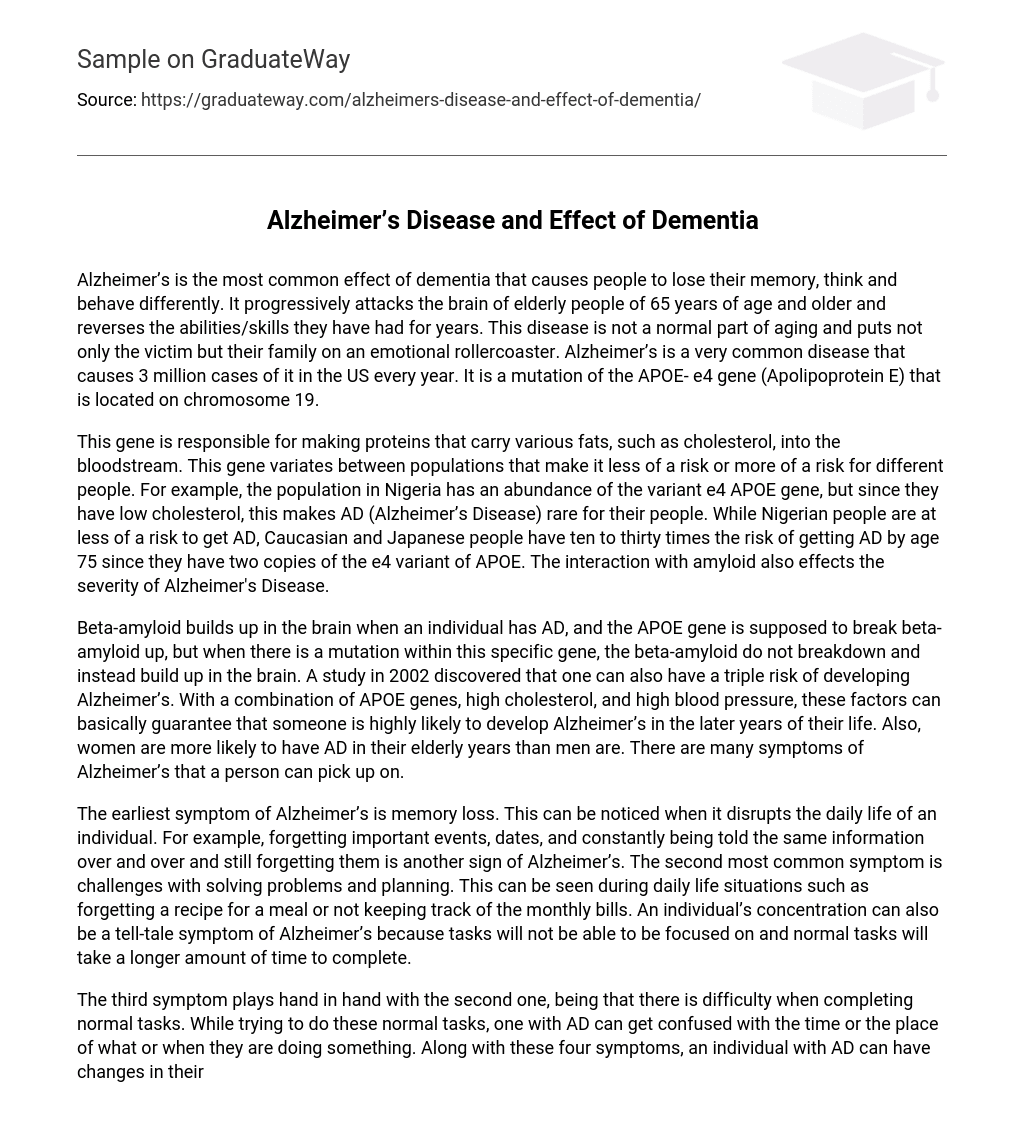Alzheimer’s is the most common effect of dementia that causes people to lose their memory, think and behave differently. It progressively attacks the brain of elderly people of 65 years of age and older and reverses the abilities/skills they have had for years. This disease is not a normal part of aging and puts not only the victim but their family on an emotional rollercoaster. Alzheimer’s is a very common disease that causes 3 million cases of it in the US every year. It is a mutation of the APOE- e4 gene (Apolipoprotein E) that is located on chromosome 19.
This gene is responsible for making proteins that carry various fats, such as cholesterol, into the bloodstream. This gene variates between populations that make it less of a risk or more of a risk for different people. For example, the population in Nigeria has an abundance of the variant e4 APOE gene, but since they have low cholesterol, this makes AD (Alzheimer’s Disease) rare for their people. While Nigerian people are at less of a risk to get AD, Caucasian and Japanese people have ten to thirty times the risk of getting AD by age 75 since they have two copies of the e4 variant of APOE. The interaction with amyloid also effects the severity of Alzheimer’s Disease.
Beta-amyloid builds up in the brain when an individual has AD, and the APOE gene is supposed to break beta-amyloid up, but when there is a mutation within this specific gene, the beta-amyloid do not breakdown and instead build up in the brain. A study in 2002 discovered that one can also have a triple risk of developing Alzheimer’s. With a combination of APOE genes, high cholesterol, and high blood pressure, these factors can basically guarantee that someone is highly likely to develop Alzheimer’s in the later years of their life. Also, women are more likely to have AD in their elderly years than men are. There are many symptoms of Alzheimer’s that a person can pick up on.
The earliest symptom of Alzheimer’s is memory loss. This can be noticed when it disrupts the daily life of an individual. For example, forgetting important events, dates, and constantly being told the same information over and over and still forgetting them is another sign of Alzheimer’s. The second most common symptom is challenges with solving problems and planning. This can be seen during daily life situations such as forgetting a recipe for a meal or not keeping track of the monthly bills. An individual’s concentration can also be a tell-tale symptom of Alzheimer’s because tasks will not be able to be focused on and normal tasks will take a longer amount of time to complete.
The third symptom plays hand in hand with the second one, being that there is difficulty when completing normal tasks. While trying to do these normal tasks, one with AD can get confused with the time or the place of what or when they are doing something. Along with these four symptoms, an individual with AD can have changes in their mood or personality, decreased or poor judgement, misplacing objects and not having the ability to retrace their steps, and withdrawal from society/work.
All of these symptoms can be easily noticed in time, and if they aren’t a doctor usually picks up on things such as AD as an individual gets older. Although you would think there is extensive research on how to prevent Alzheimer’s and Dementia, there actually isn’t. Researchers now, though not conclusive, are saying that this disease can be prevented by changing your lifestyle choices, such as how active you are and the type of foods you choose to consume. By changing these two things over a period of time, it could possibly strengthen your brain health and hopefully be able to kickback any protein buildup that starts to occur if you do have the mutation.
There are also many links to Alzheimer’s that we did not know about but do now. For example, serious head trauma is linked with Alzheimer’s, especially when the head trauma includes the loss of consciousness. To avoid this linkage, there are simple safety precautions you can take to protect your head, such as wearing a seatbelt and always wearing a helmet when it is necessary. Another strong link to Alzheimer’s is certain types of cardiovascular diseases such as high cholesterol, diabetes, and high blood pressure.
Autopsy studies show that almost eighty percent of people with Alzheimer’s also have a cardiovascular disease that is related to it. Since the heart and head are beginning to look so strongly connected, researchers are searching for an answer in cardiovascular diseases, but more research is needed to full proof this theory. Patients that are diagnosed need one thing from their families; support. Without this, they are going to waste away from the constant confusion and memory loss they experience from day to day.
From personal experience, my grandmother has Alzheimer’s and every day is a different day. Although she won’t say it, I know she needs someone to constantly be there with her to sort through her thoughts and confusion, and to help wipe away some fog from distant events that she so desperately wants to remember. I’m not going to lie, it requires a lot of patience to be able to deal with constant memory loss, but you shouldn’t leave them there to deal with it alone.
The Alzheimer’s Association says that it is important to educate yourself about the disease, stay in touch, and to just be patient. They need someone to be there for them and although it is hard, families should make the victim of Alzheimer’s comfortable and not allow them to feel bad about their situation. Life comes with many curveballs, Alzheimer’s being one of them, and it is important to stay positive and be a shoulder for a family member/friend with Alzheimer’s Disease.





